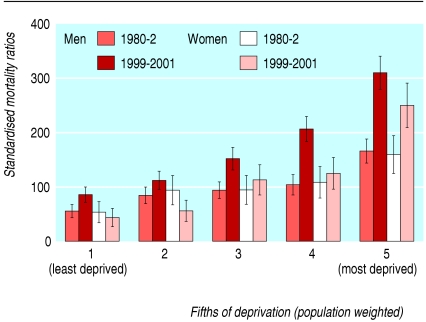The number of deaths from suicide increased among young adults between 1981-3 and 1991-3 but fell among older adults.1,2 The gap between such deaths in the most and least deprived areas of Scotland widened during this period, particularly for young adults. We examine changes in suicide rates between 1980-2 and 1999-2001 by area according to deprivation for young men and women to test whether the gap has widened further.
Participants, methods, and results
The general register office for Scotland provided data on deaths from suicide and undetermined causes for 1980-2 and 1999-2001 (international classification of diseases, ninth revision (ICD-9), codes E950-E959 E980-E989; ICD-10 X60-X84, Y10-Y34, Y87.0). These were aggregated from the postcodes of those who died to about 10 000 small areas (CATTs) which are consistent through time.3 The suicide rate declined significantly among older adults aged 3 45 years, from 22.99 per 100 000 (95% confidence interval 21.69 to 24.29) in 1980-2 to 16.73 (15.73 to 17.73) in 1999-2001, but increased significantly from 15.38 (14.38 to 16.38) to 24.32 (23.12 to 25.52) among younger adults aged 15-44 years. The rate increased significantly from 22.13 (20.43 to 23.83) to 38.65 (36.45 to 40.85) for young men. The rate also increased in young women but this was not significant (from 8.62 (7.52 to 9.72) to 10.55 (9.45 to 11.65)).
We aggregated areas into fifths of the Carstairs deprivation scores, each fifth containing about a million people in 1981 and 2001. The Carstairs scores ranged between -6.34 and 14.12 in 1981 and -5.94 and 17.47 in 2001. Mortality ratios, standardised to the national age-sex distribution in the 1981 census, were calculated by fifths for both periods.
For older adults (3 45 years), suicide rates declined significantly in all deprivation fifths, and the ratio between the most and least deprived fifths widened slightly from 1.51 (1.26 to 1.81) to 1.81 (1.50 to 2.21). The gap widened much more for young adults (15-44 years) from 2.98 (2.4 to 3.72) to 4.02 (3.34 to 4.85), though this was not significant. It widened from 2.99 (2.31 to 3.87) to 3.67 (2.98 to 4.51) in young men but from 2.96 (1.95 to 4.50) to 5.77 (3.77 to 8.85) for young women (figure), explained partly by a fall in suicides in the least deprived fifth for young women that was not seen for young men (unlike 1981, the 2001 standardised mortality ratio was significantly lower for women than men in the lowest fifth). The number of suicides rose considerably more for young men in the most deprived fifth, although the 2001 standardised mortality ratio was not significantly higher for men than for women in the highest fifth.
Figure 1.
Suicide among people aged 15-44 years in Scotland according to deprivation: 1980-2 and 1999-2001
Comment
The number of suicides increased for young adults in a 20 year period when the number among older adults declined. The rise in standardised mortality ratios was larger for young men (72.43%) than young women (19.04%). The suicide gap between the most and least deprived areas widened more for young women; there were over six times as many deaths in the most compared with the least deprived fifth in 1999-2001 (152 v 24). For young men the rates rose in every fifth, with a particularly large and significant rise in the most deprived fifth.
Recent media and political attention has focused on rising suicide rates among young men. The relative rise in suicides among young people in poor areas in Scotland, however, has increased during the 1990s and warrants more attention. While suicide polarisation is greater for young women, partly because of declines in the numbers in less deprived areas, the suicide rate in the most deprived fifth is particularly high for young men.
The Scottish Executive aims to reduce the number of suicides by 20% between 2003 and 2013.4 One “priority risk group” is defined geographically as “people in isolated or rural communities.” Those in the most deprived areas are not prioritised, although the executive acknowledges that efforts are needed to help vulnerable people in society and address inequalities. Various factors that influence suicide, such as drug misuse, divorce, and unemployment are more common in deprived areas.5 Our results suggest that these areas should be targeted among the “priority risk groups” in the future.
What is already known on this topic
Suicide is more common in Scotland than in the rest of the United Kingdom, and rates have been rising, particularly among young men
What this study adds
There is a growing social polarisation of suicide among young people in the most deprived parts of Scotland.
This article was posted on bmj.com on 22 December 2004: http://bmj.com/cgi/doi/10.1136/bmj.38328.559572.55
Contributors: All authors participated in design, execution, analysis, and writing up of different parts of the study. PB had the main coordinating responsibility for the study design and DE for the analysis. PB is guarantor.
Funding: DE was funded by an overseas research studentship award. This research was undertaken as part of his PhD dissertation.
Competing interests: None declared.
Ethical approval: Not required.
References
- 1.McLoone P. Suicide and deprivation in Scotland. BMJ 1996;312: 543-4. [DOI] [PMC free article] [PubMed] [Google Scholar]
- 2.McLoone P, Boddy FA. Deprivation and mortality in Scotland, 1981 and 1991. BMJ 1994;309: 1465-74. [DOI] [PMC free article] [PubMed] [Google Scholar]
- 3.Exeter D, Boyle PJ, Feng Z, Flowerdew R, Schierloh N. The creation of `consistent areas through time' (CATTs) in Scotland, 1981-2001. Population Trends (in press). [PubMed]
- 4.Scottish Executive. Choose life: a national strategy and action plan to prevent suicide in Scotland. Edinburgh: Stationery Office, 2002.
- 5.Gunnell D, Frankel S. Prevention of suicide: aspirations and evidence. BMJ 1994;308: 1227-33. [DOI] [PMC free article] [PubMed] [Google Scholar]



